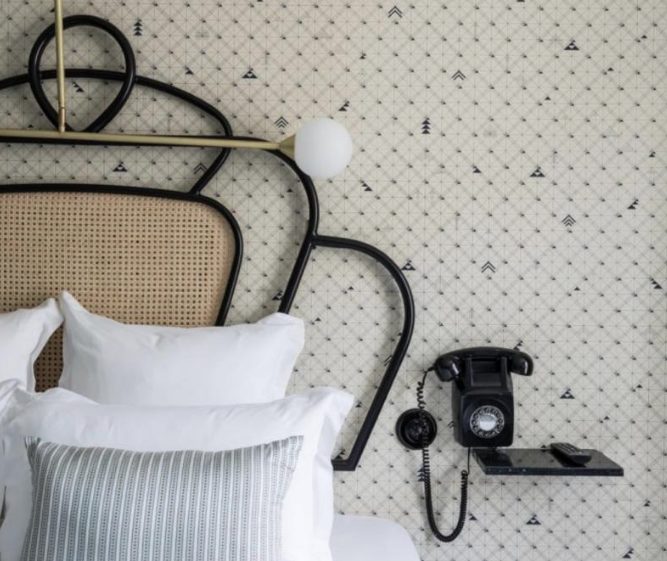French interiors exude a certain je ne sais quoi—a flair for the refined, yet effortless home. Their spaces might be chic, but they’re always welcoming and never precious. They’re classic, but with a modern edge. And, while they feature pieces from some of the most iconic designers of the 20th century, they never feel ostentatious. So, how do French women achieve the perfect tension between different styles, periods, and formalities? We tapped the expertise of Constance Gennari, the Parisian founder of The Socialite Family, a website that features the homes of everyday French families. Having visited and photographed the homes of hundreds of smart, and discerning Parisians, we knew she would have a lot to say on the matter. We weren’t disappointed—find out what makes Parisian homes so covetable, and how to achieve the look yourself.
EMBRACE IMPERFECTION
When we asked Gennari what were the fundamental differences between decorating in the States and decorating in France she replied, “There is more perfectionism in American style than in France.” The French treasure family heirlooms and pieces that aren’t pristine. They won’t dismiss a chair if the leather is stained, and don’t mind a crooked hardwood floor. The result: a space that feels more lived-in than immaculate.
MASTER THE MIX
“The French love to mix vintage and contemporary furniture, whereas there is more homogeneity in the American style,” says Gennari. French designers have no qualms about placing a modern chair beside an 18th-century dresser or having ultra-modern lighting against a ornate background. It’s all about the dynamic tension that exists between different periods and styles.
BE AUDACIOUS
According to Gennari, there are three secrets to decorating like the French: being aware that perfection does not exist, knowing how to mix different styles, and being audacious in your choices. Don’t worry too much about how pieces will fit together, as long as the proportions are right, and you truly love each piece—you will find your own personal style through trial and error.
DRAW FROM YOUR HISTORY
“My style is linked to my personal education,” says Gennari. “I grew up with a father from Milan and a mother from Paris. My mother who is an artist has a broad collection of Empire style and 18th-century furniture. I spent my childhood at Les Puces with her negotiating with the merchants. This is where my style hails from,” she says.
Incorporate pieces that your family collected in your décor—did they have a midcentury penchant; a collection of nautical memorabilia; or rugs and textiles from their own family heritage? Weave these pieces in with your own personal taste to create a sense of history in your home.
EDUCATE YOURSELF
While these chairs may seem like your average schoolhouse style, a discerning eye knows that these iconic chairs were designed by Jean Prouvé, one of the most influential designers of the 20th century. If a particular style interests you, read up on its history, and get to know the designers that created the movement. “I like Gino Sarfatti’s lights, Osvaldo Borsani chairs, Pierre Paulin desks, Alain Richard’s lights,” says Gennari. If these names sound new to you, they may be a good place to start.
BE FORSUAL
When prompted to choose between formal and casual, Gennari spontaneously answered, “Forsual, of course!” Find the right balance in your space where you can easily entertain for a more formal affair when required, but can still enjoy your space every day without being too precious about stains, scratches, and marks.
ADOPT CONTRADICTIONS
In addition to mixing materials and blending styles, Gennari, believes contradictions characterise a French interior. Want your bedroom to be a mix of French provençal with midcentury staples, and contemporary art? Go for it. Think bright magenta photography will pair well with a bold chartreuse bench? Try it. Things that don’t obviously pair well together often make for the most interesting interiors.
FOLLOW YOUR OWN RULES
Traditional design rules would probably advise against using mirrors of different sizes and placing them at different heights. They would probably also discourage from using fur in your bathroom, but Gennari recommends following your own rules. Do what feels right for you, not what you were taught to be right in magazines—something that she calls her worst decorating faux pas. Just as there is a difference between fashion and style, there is a difference between trendy design rules and personal taste.
DON’T THROW OUT THE OLD
If she had to choose between old and new, Gennari says she would pick the old. It’s no surprise that her favourite place to buy décor in Paris is at Les Puces de Saint-Ouen, a larger-than-life flea market. “It’s like being in a museum with the right to buy everything,” she says. “One of the magical sides of Paris, is the diversity of décor you can find.” For contemporary furniture, she visits La Boutique Danoise, Le Monde Sauvage, Maison Nordik, Merci, La Trésorerie, and La Redoute Intérieurs. Follow the famous wedding philosophy when decorating: something old, something new, something borrowed, something blue—they don’t call it French blue for nothing.
DON’T BE MONOMANIC
One of the biggest mistakes Gennari notices in American style decorating, is “monomania for a particular colour, or style,” she says—meaning our obsessive enthusiasm for a particular style. Many interior designers have called out this issue for midcentury modern, which saw a wild resurgence post–Mad Men. They unanimously agreed that the future of design lied in a more expertly mixed, and eclectic combinations of styles—one more reason to adopt the essence of French decorating now more than ever.


